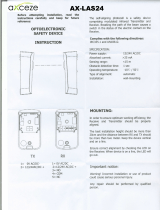
2
Inserting or Removing the Micro SD Card Installation
Before mounting a new controller, you must insert the included microSD flash memory card. Note the card has the unique Niagara
identity (host ID) for the unit, set at the factory. ALL power to the controller must be removed. If the unit is currently running, initiate a
controller shutdown.
Carefully slide the plastic microSD card shutter open. The shutter should remain captive in the base, revealing the microSD card socket.
To insert the microSD card, slide it into the card carrier, label side up, until the spring catch engages. If properly inserted, the card is
behind the shutter track.
To remove the microSD card, push it in, until the spring release pushes it partially out of the card carrier. Grasp the card, pull it
completely out of the unit and store it in a static-free protective case.
Carefully slide the card shutter back over the card carrier opening, until it clicks into place. When properly closed, the shutter should not
protrude behind the mounting base.
NOTE: Data on the microSD card is encrypted. If you swap in a card from a previously configured unit, you must change the
LMJA-8xxx-SM system passphrase on the platform to match the passphrase on the new microSD card. Typically, the microSD
card never needs removal. However, in the case where a controller has been electrically damaged or found faulty, you can
remove the card and install it in another like unit, so it can become a functional replacement.
1. Access shutter for microSD card (slide down/up to
open/close)
2. Card carrier inside controller
3. MicroSD card to insert or remove from card carrier
MOUNTING
Mount the LMJA-8xxx-SM controller in a location that allows clearance for wiring, servicing, and module removal.
Environmental Requirements
Note the following requirements for the LMJA-8xxx-SM controller mounting location:
• This product is intended for indoor use only. Altitude to 6,562 ft (2,000m).
• Ambient conditions must be within the range of: Operating Temperature: -4°F to 140°F (-20°C to 60°C), Storage Temperature: -40°F
to 185°F (-40°C to 85°C)
• Relative Humidity: 5% to 95% non-condensing, Pollution Degree 3
• Supply (mains) voltage requirements: Allowable voltage fluctuation +/- 10%
• Do not expose the unit to ambient conditions outside of the range of 0ºC (32º F) to 50ºC (122º F) and relative humidity outside the
range 5% to 95% non-condensing.
• If mounting inside an enclosure, that enclosure should be designed to keep the unit within its required operating range considering
a 24-watt dissipation by the controller, plus dissipation from any other devices installed in the same enclosure. This is especially
important if the controller is mounted inside an enclosure with other heat producing equipment.
• Do not mount the unit:
▸ In an area where excessive moisture, corrosive fumes, or explosive vapors are present
▸ Where vibration or shock is likely to occur
▸ In a location subject to electrical noise, including the proximity of large electrical conductors, electrical machinery, welding
equipment, spark igniters, and variable frequency drives, etc.
MATERIAL AND TOOLS REQUIRED
• One of the following:
▸ UL Listed, Class 2, 24VAC transformer, rated at minimum of 24VA. A dedicated transformer is required (cannot power additional
equipment), -OR-
▸ 24VDC power supply, capable of supplying at least 1A (24W), -OR-
▸ NB-PS1 wall-mount AC power adapter with barrel connector plug (included with unit)
• DIN rail, type NS35/7.5 (35mm x 7.5mm_ and DIN rail end-clips (stop clips), recommended for any installation with option modules.
Controller is also panel mountable.
• Suitable tools, fasteners, and accessories for mounting
3
2
1




















